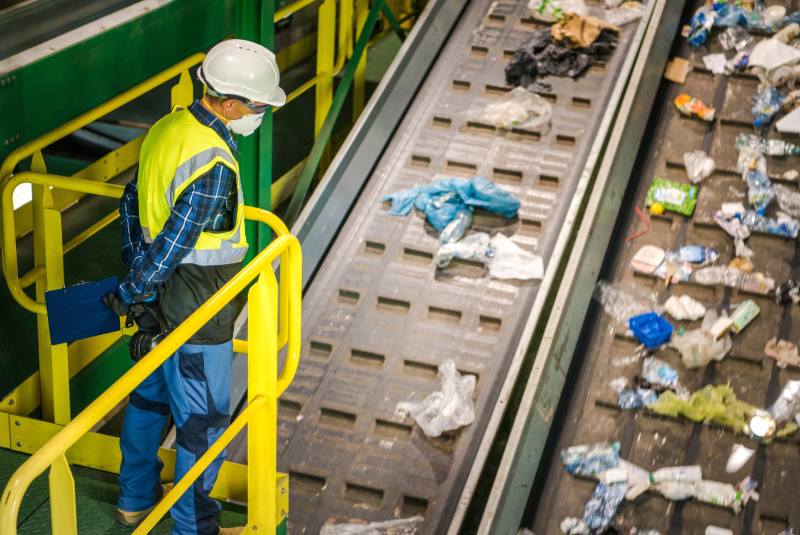Sort smarter, not harder

Sandip Singh, CEO, Ishitva® Robotic Systems, points out, “Waste management is a complicated process that involves sorting, processing, and recycling a wide variety of materials. Traditionally, it has been the real bottleneck to circularity as it requires large human interventions to identify and separate different types of waste. However, as the world increasingly focuses on sustainability and reducing landfill waste, new technologies are making this process more efficient and effective.”
Ishitva® integrates AI into segregation of waste into different categories for effective recycling. “By incorporating advanced AI into the sorting process, Ishitva® has elevated this critical task,” he says. The AI-powered sorting solutions ensure precise and efficient waste sorting, allowing recyclables to be accurately identified and separated at every stage of the waste management cycle.
AI in waste management is not new, says Tasos Bereketidis, VP Sales Emerging Markets, Tomra Recycling Sorting, “AI has always been at the heart of our industry.” Tomra’s R&D teams have been developing AI-powered sorting solutions for years. “In fact, even 30 years ago, Tomra’s machines could decide which material to sort into which container – this ability to make decisions like a human is the very definition of AI.”
“Today, when we talk about AI in recycling and sorting, we refer to the latest developments in deep learning, a subcategory of machine learning that has advanced thanks to increased computing power over the last decade,” Bereketidis points out. The latest deep learning technologies enable sorting systems to adapt faster to the ever-changing composition of waste without needing hardware replacements. “When combined with conventional sorting technologies, they achieve the highest sorting granularity. This allows for sorting by material type, colour, shape, size, and other details.”

“At Tomra, we continuously invest in this area and in our deep learning solution GAINnext we see these technologies as potent enhancements to conventional sorting machines.” Tomra has invested in PolyPerception, a promising start-up offering AI-based waste analysis, now part of our product portfolio.
“Imagine a facility where the sorting of materials isn’t left to manual labour, but is instead managed by intelligent systems capable of identifying, categorising, and separating a wide range of materials with speed and accuracy. This is the transformative vision realised by Ishitva®’s SANJIVANI® technology,” explains Singh, adding, “SANJIVANI, a fully autonomous sorting system, powered by AI, can identify various types of polymers, colours, grades, and even black objects, which have long been difficult for traditional sorting methods. The system sorts materials based on factors like polymer type, colour, and even their Melt Flow Index (MFI) or food grade, ensuring that only clean, high-quality materials are sent into the recycling stream.” Additionally, it sorts materials by volume, efficiently moving high-volume materials into the appropriate bunkers, maximizing recovery. This precision reduces contamination and ensures that materials sent for recycling are of a higher grade, leading to better recycling outcomes and higher recovery rates.
“AI helps divert more waste from landfills and decreases the need for new raw materials, helping to conserve natural resources. This creates a more sustainable, circular economy where waste is seen as a resource, not a problem,” he says.
“In short, integrating AI into waste management is like giving the process a brain—one that learns, adapts, and continuously improves,” he explains.
Sharing insights into deep learning technology, Bereketidis says it helps achieve efficiency in waste management by providing more precise sorting capabilities and solving very complex sorting tasks. “For example, our AUTOSORT combined with GAINnext can sort food-grade vs. non-food-grade PET, PP, and HDPE, which was not possible with previous technologies. This is a milestone for the industry, especially as the latter can achieve a purity rate of over 95%.”
Another example is deep learning cameras. They can be placed at key points in the sorting circuit to monitor the entire process and material flow. This enables plant operators to continuously monitor the quality of sorted streams, material loss, and ensure compliance with food recycling regulations.
Will AI eventually replace human intervention in waste management?
Bereketidis opines that AI is expected to work as a supportive tool. While AI can significantly enhance sorting accuracy and efficiency, human supervision and decision-making are crucial in managing complex waste streams and ensuring the overall effectiveness of waste management systems.
Singh says, “All the facilities where our technologies have been adopted have in fact increased the employments as they benefit immensely with efficiency which we bring into the system. And this is not limited to their own centres but also inward as well as outward value chains.” The advantages are the humans involved in these facilities do not work in unhygienic environments and they do not handle waste by hand, he points out.
AI can minimise human error, reduce contamination, and ensure that recyclable materials are of higher quality, ultimately leading to more effective recycling and higher recovery rates.
What does the future look like?
According to Bereketidis, “Recent breakthroughs in deep learning and AI have already started revolutionising waste management. The ability to sort materials with greater granularity and flexibility is a significant advancement. As AI technologies continue to evolve, we can expect even more sophisticated sorting capabilities and new applications that will further enhance material circularity and recycling efficiency.”
Drawing our attention to the importance of data, he elaborates, “We can take a big step toward process optimization with the help of data. AI-powered sorting systems generate huge amounts of data on material composition, sorting efficiency, and plant performance. By analysing this data, operators can identify optimization opportunities and act accordingly.”
Singh says the future of waste management is bright, with AI technologies driving significant advancements. “Automation will play a key role in making waste management more cost-effective, safer, and sustainable. Ultimately, AI-driven solutions will transform waste into valuable resources, driving both environmental and economic benefits for a more sustainable future.”

